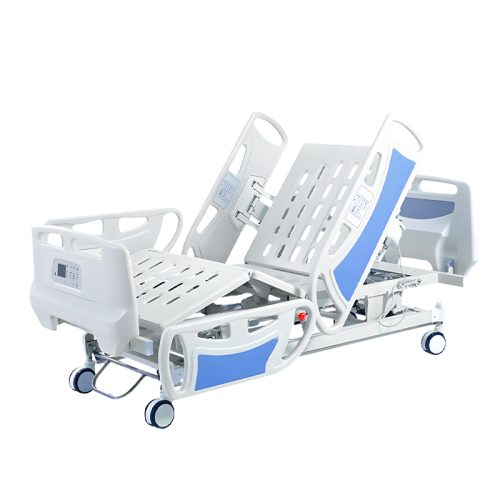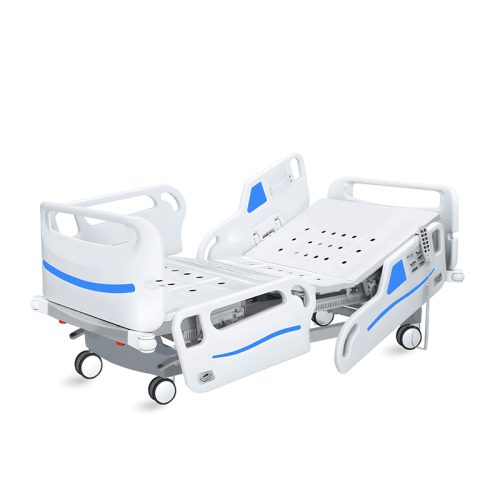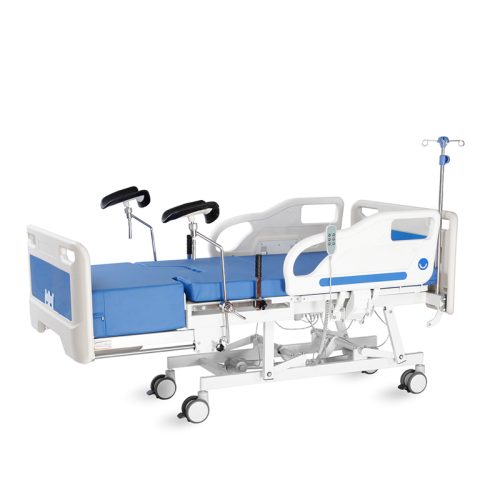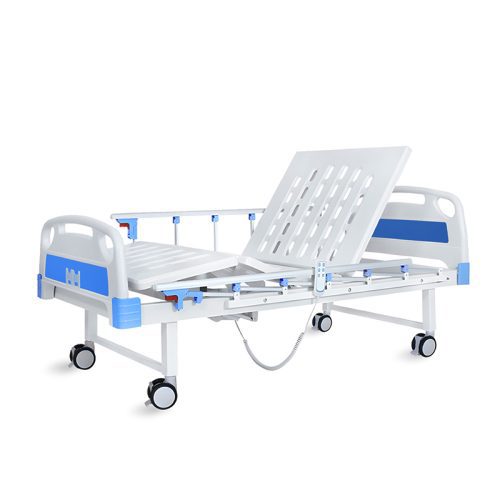
- Krankenhausbett
Der ultimative Leitfaden für die Wahl des richtigen Krankenhausbettes
- Unter kelingmedical
Dieser umfassende Leitfaden führt Sie durch die wichtigsten Faktoren und Merkmale, die Sie beim Kauf eines Krankenhausbettes berücksichtigen sollten. Jetzt, da Sie all diese Dinge wissen, können Sie eine bessere Wahl treffen und sicher sein, dass das Krankenhausbett, für das Sie sich entscheiden, die Lebensqualität, den Komfort und die Sicherheit des Patienten bestmöglich verbessert.
Arten von Krankenhausbetten
Es gibt verschiedene Arten von Krankenhausbetten, die an unterschiedliche Patienten und Umgebungen angepasst sind. Wenn Sie wissen, welche für Sie die richtige ist, können Sie sich für die richtige entscheiden.
Manuelle Krankenhausbetten
Es gibt keine elektrischen Krankenhausbetten, da die manuellen Betten mit einer Handkurbel bedient werden. Diese Betten sind in der Regel billiger und können auch von Personen oder Einrichtungen genutzt werden, die nicht über ein großes Budget verfügen. Aber sie sind gewöhnungsbedürftiger als elektrische Betten. Es handelt sich um manuelle Betten, die verwendet werden, wenn der Patient nicht häufig verstellt werden muss oder stabil ist.
Perfekt für: Kostengünstige Einrichtungen, stabile Patienten, ambulante Pflege.
Elektrische Krankenhausbetten
Elektrische Krankenhausbetten sind bequem, weil Kopf- und Fußteil sowie die Betthöhe elektrisch verstellt werden können. Diese Betten sind sowohl für den Patienten als auch für das Pflegepersonal bequem, da sie per Knopfdruck verstellt werden können. Elektrische Betten eignen sich perfekt für Patienten, die häufig umgelagert werden müssen oder die komplexer sind - mobilitätseingeschränkte, chronisch kranke oder bettlägerige Patienten.
Bevorzugte Anwendungsfälle: Patienten, die häufig umgelagert werden müssen, Langzeitpflegepatienten, häusliche Krankenpflege.
Semi-Elektrische Krankenhausbetten
Halbelektrische Krankenhausbetten sind eine Mischung aus manuellen und elektrischen Betten. Sie verfügen über eine elektrische Kopf- und Fußsteuerung für das Bett, aber in der Regel sind sie manuell höhenverstellbar. Diese Betten sind sowohl erschwinglich als auch komfortabel und werden daher häufig in Gesundheitseinrichtungen verwendet.
Am besten geeignet für: Pflegeheime, die ein elektrisches Tuning zu einem niedrigeren Preis wünschen.
Niedrige Krankenhausbetten
Die niedrigen Krankenhausbetten neigen dazu, sich dem Boden zu nähern und sich abzusenken, damit Menschen, die das Bett verlassen wollen, nicht stürzen. Sie sind besonders praktisch für ältere Patienten oder solche mit erhöhtem Sturzrisiko.
Am besten geeignet für: Patienten mit Sturzrisiko, ältere Erwachsene, nach einer Operation oder Verletzung.
Bariatrische Krankenhausbetten
: Bariatrische Krankenhausbetten sind für schwerere oder besonders große Patienten gedacht. Diese Betten sind stärker belastbar und haben eine große Liegefläche, um den Komfort und die Sicherheit des Patienten zu gewährleisten.
Ideal für: Übergewichtige Patienten oder Menschen, die mehr Platz brauchen, um sich auszustrecken und sich wohl zu fühlen.
Zu beachtende Hauptmerkmale
Beim Kauf eines Krankenhausbettes gibt es viele Dinge zu beachten, wenn Sie sich für ein Bett entscheiden, das für den Patienten bequem, sicher und einfach zu bedienen ist.
Einstellbarkeit
Für den Patientenkomfort und die Bequemlichkeit des Pflegepersonals kann es sehr wichtig sein, die Höhe sowie die Kopf- und Fußposition des Bettes zu kennen. Ein teleskopisches Krankenhausbett ermöglicht es dem Pflegepersonal, den Patienten rücken- und gelenkschonend von einer Position in die andere zu bringen.
Kopf- und Fußanpassungen: Sie können das Kopf- oder Fußteil des Bettes anheben, um bestimmte Beschwerden zu behandeln, wie z. B. Atembeschwerden, Kreislaufprobleme und Schmerzen.
Höhenverstellung: Wenn das Bett erhöht oder abgesenkt werden kann, um einer Pflegeperson entgegenzukommen, kann das Bett von der Pflegeperson leichter bewegt werden und Verletzungen werden minimiert.
Seitenschienen
Die Seitengitter sind eine großartige Sicherheitsmaßnahme, insbesondere wenn Patienten häufig aus dem Bett fallen. Sie halten den Patienten sicher und verringern Unfälle wie Stürze, die oft mitten in der Nacht oder bei bewusstlosen oder verwirrten Patienten passieren. Die Seitengitter werden normalerweise je nach Bedarf des Patienten angehoben oder abgesenkt.
Am besten geeignet für: Patienten, die verlegt werden, Patienten über 50 Jahre oder Patienten mit eingeschränkter Mobilität.
Gewichtskapazität
Es gibt unterschiedliche Gewichtsklassen von Krankenhausbetten, daher müssen Sie ein Bett wählen, das für den Patienten sicher ist. Die meisten normalen Betten wiegen etwa 350 Pfund, während bariatrische Betten auch für größere Körper geeignet sind.
Empfohlen für: Schwerlastbetten sollten für Patienten ausgewählt werden, die übergewichtig sind oder den normalen Gewichtsbereich überschreiten.
Matratzen-Kompatibilität
Krankenhausbetten werden oft zusammen mit speziellen medizinischen Matratzen gekauft. Es ist die Matratze, die einen Patienten so lange wie möglich im Bett hält, ohne dass er sich dabei wundliegt. Viele Krankenhausbetten können mit druckfreien Matratzen verwendet werden, um Druckgeschwüre zu verhindern.
Für: Dekubitusgefährdete Patienten, nicht mobile Menschen und chronisch Kranke.
Manövrierfähigkeit und feststellbare Rollen
Auch Krankenhausbetten müssen transportabel sein, insbesondere für die stationäre Pflege, wo nicht immer Platz zur Verfügung steht. Ziehen Sie Betten mit stabilen Rädern oder schwenkbaren Rollen in Betracht, damit Sie das Bett mühelos bewegen können. Außerdem sollte es über feststellbare Rollen verfügen, damit das Bett im Notfall an seinem Platz bleibt und sich während der Pflege nicht unnötig bewegt.
Empfohlen für: Patienten, die häufig umgelagert werden müssen, und Ärzte, die das Bett auf engem Raum umstellen müssen.
Benutzerfreundlichkeit für Pflegekräfte
Sie möchten, dass das Bett für das Pflegepersonal einfach zu bedienen ist, entweder durch Kurbeln oder durch Tasten. Achten Sie auf Betten mit einfach zu bedienenden Steuerelementen und weniger Aufwand, um das Bett genau richtig einzustellen. - Fernbedienungen sind ebenfalls ein gängiges Element bei elektrischen Betten, so dass Sie das Bett steuern können, ohne es anfassen zu müssen.
Ideal für: Leistungserbringer, die Patienten häufig sehen und die körperliche Belastung verringern müssen.
Langlebigkeit und Konstruktion
Krankenhausbetten müssen langlebig und stabil sein, damit die Patienten sicher bleiben können. Suchen Sie nach Betten, die solide gebaut sind und deren Materialien bei häufigem Gebrauch, z. B. in einem Krankenhaus, haltbar sind. Betten aus Stahl oder hochfestem Aluminium sind in der Regel robuster und halten länger.
Für Krankenhäuser, Kliniken und ein Langzeitpflegezentrum.
Patientenkomfort
Komfort ist im Krankenhausbett wichtig, wenn die Patienten längere Zeit im Bett liegen müssen. Verstellbare Kopfstützen, Matratzen mit Komfortpolsterung und weiche Polsterung können den Komfort für den Patienten erhöhen.
Am besten geeignet für: Patienten, die eine Operation hinter sich haben oder unter chronischen Schmerzen leiden.
Krankenhausbett für zu Hause oder Krankenhausbett für das Krankenhaus?
Krankenhausbetten leisten fast dasselbe, aber Krankenhausbetten zu Hause sind kleiner, billiger und benutzerfreundlicher. Sie sind so konzipiert, dass sie für das Pflegepersonal zu Hause zugänglich sind und über intuitive Funktionen wie Fernbedienungen für die Bettverstellung und einfachere Formulare verfügen.
Betten für den Hausgebrauch: Sie sind leichter, einfacher zu verstellen und verfügen über einige grundlegende Sicherheitsoptionen wie Seitengitter und Höhenverstellung.
Krankenhausbetten: In der Regel höherwertig mit einigen Extras für Ärzte, wie z. B. einem integrierten Überwachungssystem, und langlebiger für den Dauereinsatz.
Schlussfolgerung
Bei der Auswahl des richtigen Krankenhausbettes kommt es auf den Komfort, die Sicherheit und das Wohlbefinden des Patienten an. Ganz gleich, ob Sie ein Bett für zu Hause, ein Krankenhausbett oder ein Pflegebett suchen, es gibt ein paar Dinge, auf die Sie achten müssen: Verstellbarkeit, Sicherheit, Haltbarkeit und die Bedürfnisse des Patienten.
Sie wissen dies und kennen die verschiedenen Krankenhausbetten, die Sie bekommen können, so dass Sie eine kluge Entscheidung treffen können, um eine optimale Versorgung für den Patienten und für das Pflegepersonal zu gewährleisten.
📧 E-Mail: inquiry@shkeling.com
🌐 Website: www.shkeling.com.cn
Wir freuen uns darauf, mit Ihnen eine erfolgreiche Partnerschaft aufzubauen!






